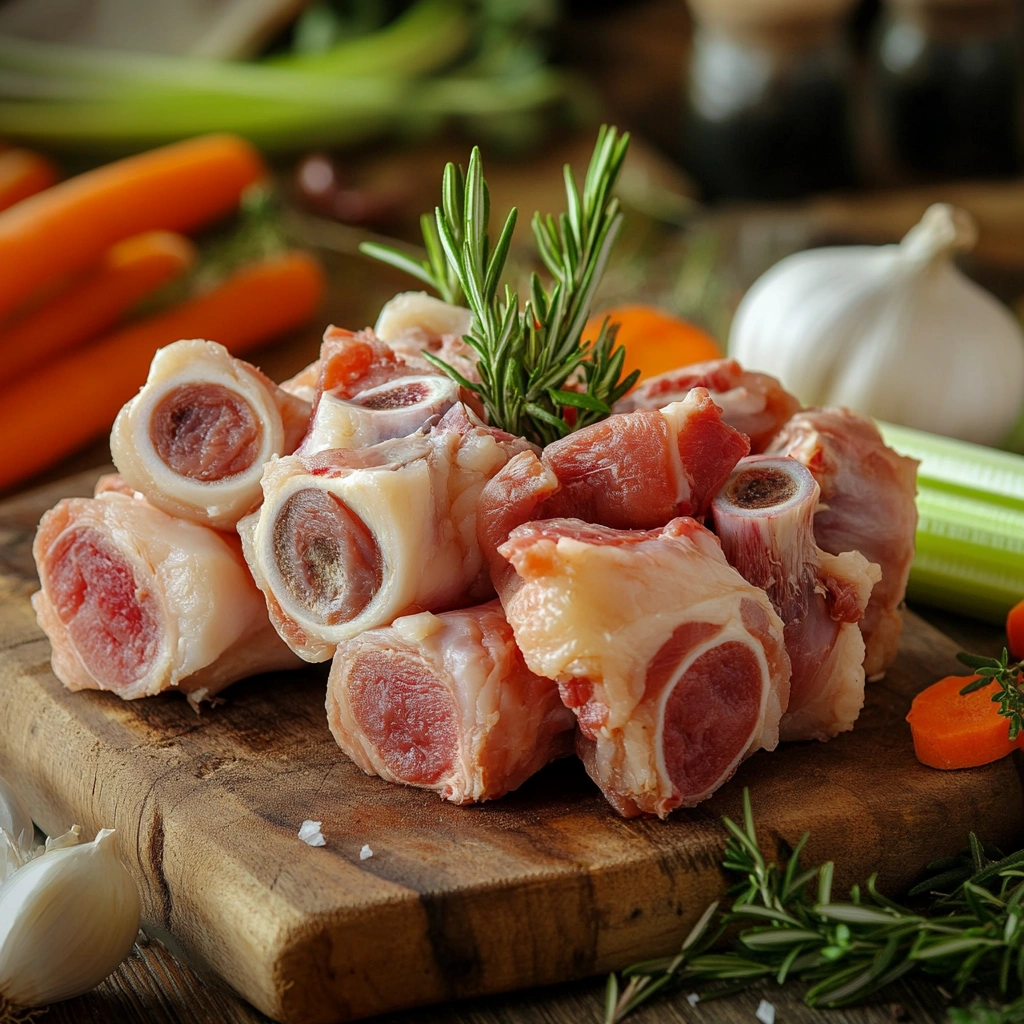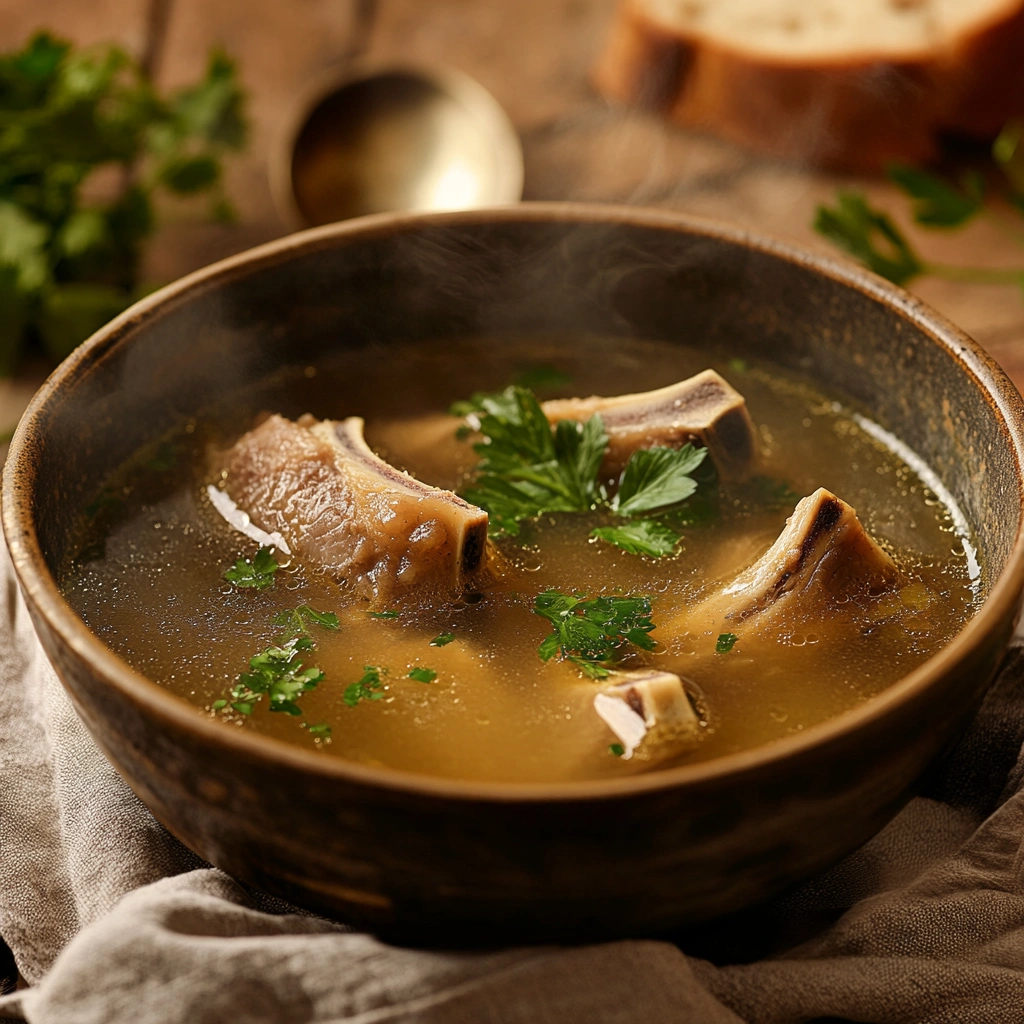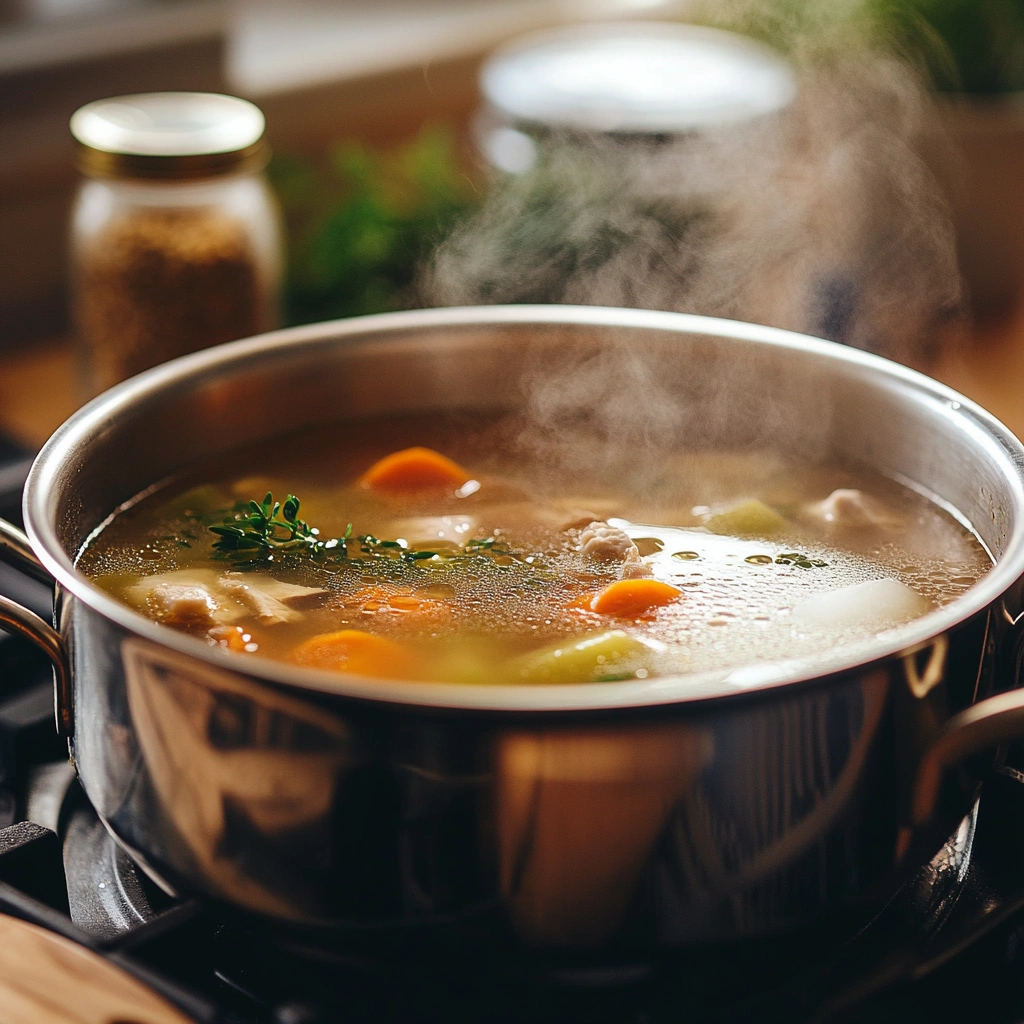1. Introduction
When it comes to creating rich, flavorful soups and stews, the soup bone is an irreplaceable kitchen staple. Known for its ability to add depth, nutrition, and heartiness to meals, soup bones have been used in cuisines across the globe for centuries. Whether you’re making a comforting chicken soup on a chilly day or preparing a luxurious beef broth for a gourmet dish, soup bones are the secret to success.
But what exactly is a soup bone? Why are they so highly regarded in culinary traditions? In this comprehensive guide, we’ll explore everything you need to know about marrow bones—from their history and types to their nutritional benefits and preparation techniques. Whether you’re a seasoned chef or a home cook eager to experiment, understanding bone broth will elevate your cooking game and help you create dishes that are both delicious and wholesome.
Before we dive in, let’s clarify what a soup bone is and how it’s different from regular cuts of meat.
2. Understanding Soup Bones
2.1 What is a Soup Bone?
A soup bone is typically a bone from an animal—such as beef, pork, or poultry—that is used to make soup, broth, or stock. These bones often contain remnants of meat, marrow, and connective tissue, all of which contribute to the rich flavors and textures that make soups and stews irresistible.
marrow bones can include a variety of bone types, such as:
- Beef knuckles and shanks: Known for their high collagen content, these bones produce a gelatinous and flavorful broth.
- Pork trotters and neck bones: Often used in Asian and Southern cuisines for their robust flavor and richness.
- Chicken carcasses and feet: Popular in many cultures for making light, nutrient-packed broths.
Soup bones are valued not just for their flavor but also for the nutrients they impart. The marrow inside the bone is particularly prized for its creamy texture and health benefits.
2.2 Culinary Terminology: Soup Bone Slang
In culinary slang, the term soup bone can have different meanings depending on the context. Traditionally, it refers to bones specifically chosen for making soup or broth. However, in some circles, it has become a colloquial term for anything “leftover” or “extra” that can be used to add depth to a dish.
Interestingly, the phrase marrow bones also pops up in pop culture and casual conversation as slang for thin or emaciated body parts, like “soup-bone arms.” In culinary traditions, however, it’s all about richness and substance.
3. Selecting the Best Bones for Soup
Choosing the right soup bones is an art in itself. The type of bone you select directly impacts the flavor, texture, and nutritional value of your broth or soup. Here’s a guide to help you make the best choice:
3.1 Criteria for Choosing Soup Bones

Alt Text: Raw soup bones with fresh vegetables on a wooden cutting board.
When selecting marrow bones, consider the following factors:
- Marrow Content: Bones with a high amount of marrow, like femur or knuckle bones, create a rich and creamy broth.
- Meatiness: Look for bones that still have some meat attached, such as shanks or oxtails, as this enhances the broth’s flavor and makes it more filling.
- Collagen Levels: Connective tissues, such as tendons and ligaments, are essential for a gelatinous broth that’s packed with nutrients.
3.2 Best Bones for Various Types of Broths
Different types of bones bring unique flavors and properties to your soup. Here are some recommendations:
- Beef Bones:
- Knuckle Bones: High in collagen, ideal for thick and hearty broths.
- Shanks: Add a deep, beefy flavor and contain a good amount of marrow.
- Oxtails: A luxurious option for a rich, flavorful soup.
- Poultry Bones:
- Chicken Carcasses: Perfect for a light and clear chicken broth.
- Chicken Feet: Rich in gelatin, they add a silky texture to soups.
- Turkey Necks: Great for a more robust poultry flavor.
- Pork Bones:
- Trotters: High in collagen and perfect for creating thick, creamy soups.
- Neck Bones: Often used in Southern and Asian cuisines for their strong flavor.
3.3 Ethical and Sustainable Sourcing
Ethical sourcing of soup bones not only benefits the environment but also ensures better flavor and nutritional quality. Here’s why:
- Grass-Fed and Free-Range Animals: These animals produce bones with higher levels of nutrients and better flavor.
- Sustainability: Purchasing from local farms or using leftovers from butchering reduces waste and supports small businesses.
- Environmental Impact: Choosing ethically raised animals minimizes the carbon footprint associated with factory farming.
By considering these factors, you can choose soup bones that are both delicious and environmentally responsible.
4. Nutritional Benefits of Soup Bones
Soup bones are a powerhouse of nutrition, offering a range of health benefits that go beyond just flavor. Let’s explore what makes them so beneficial:
4.1 Rich Source of Collagen and Gelatin
One of the most valuable components of marrow bones is collagen, a protein that breaks down into gelatin when cooked. Collagen is known for its numerous health benefits, including:
- Skin Health: Collagen helps improve skin elasticity and reduce the appearance of wrinkles.
- Hair and Nail Strength: Regular consumption can make your hair shinier and your nails stronger.
4.2 Essential Minerals and Amino Acids
bone broth are rich in essential minerals such as:
- Calcium: Supports strong bones and teeth.
- Magnesium: Plays a role in over 300 biochemical reactions in the body.
- Phosphorus: A vital component of DNA and cell repair.
Additionally, they contain amino acids like:
- Glycine: Promotes better sleep and cognitive function.
- Proline: Supports joint and tissue repair.
4.3 Joint and Gut Health
The compounds found in marrow bones, particularly gelatin and glucosamine, contribute significantly to joint and gut health:
- Joint Support: Helps maintain the integrity of cartilage and reduces inflammation in joints.
- Gut Healing: Gelatin supports the lining of the digestive tract, making it beneficial for people with conditions like leaky gut syndrome.
By incorporating soup bones into your diet, you’re not just enjoying a flavorful meal—you’re investing in your overall health.
5. Culinary Uses of Soup Bones
Soup bones are incredibly versatile in the kitchen, serving as the foundation for many iconic dishes. Their ability to infuse flavor and nutrients into meals makes them a must-have for both traditional and modern cooking.
5.1 Making Bone Broth and Stock
Bone broth and stock are two of the most popular uses for marrow bones. Here’s a quick guide to creating these culinary staples:
- Bone Broth:
- Use beef knuckles, chicken feet, or pork trotters for a nutrient-dense, gelatin-rich broth.
- Simmer the bones for 12–24 hours to extract maximum flavor and nutrients.
- Add aromatics like onions, carrots, celery, and herbs for enhanced flavor.
- Stock:
- Stocks are typically simmered for 2–6 hours and serve as a base for soups, sauces, and gravies.
- Use roasted bones for a deeper flavor profile, especially for beef or veal stocks.
5.2 Enhancing Soups and Stews
Soup bones transform simple soups and stews into rich, hearty dishes. Here’s how they work:

Alt Text: A bowl of steaming bone broth with meat and marrow bones.
- Flavor Boosters: Bones release marrow and minerals, creating a robust and savory taste.
- Texture Enhancement: The collagen in bone broth thickens the broth, giving it a luxurious mouthfeel.
- Versatile Applications: Use marrow bones in vegetable soups, lentil stews, or even curries to add depth and complexity.
5.3 International Dishes Featuring Soup Bones
Soup bones are celebrated in cuisines worldwide. Some examples include:
- Korean Gamjatang: A spicy pork bone soup featuring potatoes, greens, and a rich, flavorful broth.
- Filipino Bulalo: A comforting soup made with beef shanks, corn, and cabbage.
- Mexican Caldo de Res: A hearty beef soup with vegetables like zucchini, potatoes, and carrots.
- French Pot-au-Feu: A classic dish where beef bones are simmered with vegetables and herbs.
These dishes highlight the global love for bone broth and their ability to elevate any recipe.
6. Cooking Techniques for Soup Bones
Cooking soup bones is a straightforward process, but a few techniques can help you maximize their flavor and nutritional value.
6.1 Roasting Bones for Enhanced Flavor
Roasting marrow bones before simmering brings out their natural flavors and creates a more complex broth.
Steps to Roast bone broth:
- Preheat your oven to 400°F (200°C).
- Place the bones on a baking sheet in a single layer.
- Roast for 20–30 minutes until they’re browned and aromatic.
- Transfer to a pot or slow cooker to begin the broth-making process.
Roasting is especially recommended for beef and pork bones to achieve a deep, caramelized taste.
6.2 Simmering Times and Methods
The simmering process is where the magic happens. Different bones and cooking methods require varying times:

Alt Text: Simmering bone broth with soup bones, herbs, and vegetables.
- Stovetop:
- Ideal for smaller batches of broth. Simmer on low heat for 4–12 hours.
- Slow Cooker:
- Perfect for hands-off cooking. Cook on low for 12–24 hours.
- Pressure Cooker:
- Best for quick results. Cook at high pressure for 1–2 hours.
Regardless of the method, avoid boiling, as it can create a cloudy broth.
6.3 Clarifying and Storing Broth
To achieve a clear, flavorful broth, follow these tips:
- Clarifying Broth:
- Skim off any foam or impurities during the simmering process.
- Strain the broth through a fine-mesh sieve or cheesecloth.
- Storing Broth:
- Refrigerate for up to 5 days in an airtight container.
- Freeze in ice cube trays or portioned containers for long-term storage.
Proper cooking techniques ensure that your soup bones deliver maximum flavor, nutrition, and versatility in the kitchen.
7. Health Considerations and Myths
Soup bones are often touted for their health benefits, but it’s important to separate fact from fiction. This section dives into the health considerations and debunks common myths surrounding soup bones.
7.1 Are Soup Bones Good to Eat?
While bone broth themselves aren’t typically eaten, the nutrients they release during cooking make them incredibly beneficial. Here’s what to know:
- Edibility of Marrow:
- The marrow inside marrow bones is not only edible but also rich in healthy fats, vitamins, and minerals.
- Many cultures savor roasted marrow as a delicacy, often spread on toast or mixed into dishes.
- Residual Meat:
- Meat attached to the bones is flavorful and tender, often falling off during cooking.
- This can be used in soups or enjoyed on its own.
7.2 Addressing Health Claims
Soup bones are often linked to impressive health claims, but not all are fully substantiated:
- Proven Benefits:
- Collagen and gelatin support joint and skin health.
- Minerals like calcium and magnesium promote strong bones and teeth.
- Controversial Claims:
- While bone broth is nutrient-dense, claims about it curing illnesses like arthritis lack strong scientific backing.
- It’s best to view bone broth as a supplement to a balanced diet rather than a miracle cure.
7.3 Potential Risks and Precautions
Though generally safe, there are a few precautions to consider when using bone broth:
- Lead Contamination:
- Research suggests that bones may contain trace amounts of lead.
- Opt for bones from trusted, ethically sourced suppliers to minimize risk.
- Food Safety:
- Proper storage and cooking methods are crucial to prevent bacterial contamination.
- Always refrigerate or freeze bones until you’re ready to use them.
By understanding these considerations, you can safely enjoy the many benefits of soup bones without falling for unfounded myths.
8. Frequently Asked Questions (FAQs)
This section addresses common questions about marrow bones, helping readers gain a deeper understanding of their uses and benefits.
8.1 What is a Soup Bone?
A bone broth is a bone from an animal, often containing marrow and remnants of meat, used to make soups, broths, and stocks. Common examples include beef knuckles, pork trotters, and chicken carcasses.
8.2 What is a Soup Bone Slang?
In culinary terms, “soup bone” refers to a bone used for cooking soups or broths. However, in slang, it may describe something thin or emaciated, like a “soup-bone arm.”
8.3 What is the Best Bone for Soup?
The best bone depends on the type of soup or broth you’re making:
- Beef: Knuckle bones, shanks, and oxtails.
- Poultry: Chicken feet, necks, and carcasses.
- Pork: Trotters and neck bones.
8.4 Are Soup Bones Good to Eat?
While the bones themselves aren’t eaten, the marrow and meat they contain are highly nutritious. The nutrients released during cooking also make the broth a healthy addition to your diet.
9. Conclusion
Soup bones are a cornerstone of culinary tradition, valued for their ability to transform simple ingredients into flavorful and nutrient-rich dishes. Whether you’re crafting a hearty stew, a clear broth, or an elaborate international dish, the humble soup bone delivers unmatched depth and complexity.
Beyond their culinary uses, bone broth offer a wealth of health benefits, from supporting joint and skin health to providing essential minerals and amino acids. Their versatility and affordability make them an accessible and sustainable choice for home cooks and chefs alike.
By incorporating soup bones into your cooking, you can elevate your meals while enjoying their nutritional benefits. Embrace the time-honored tradition of cooking with marrow bones and experience the magic they bring to your kitchen.
